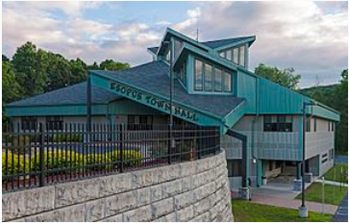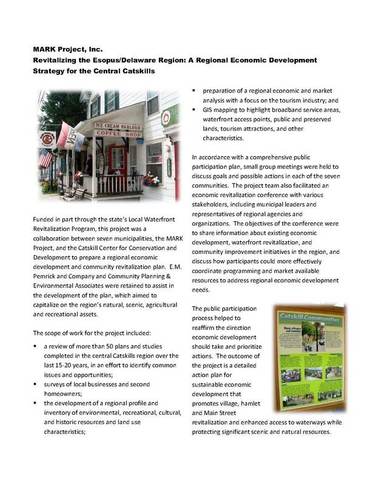
Esopus-Delaware, Ulster County, NY
Esopus-Delaware Comprehensive Plan
Public Participation: Esopus-Delaware Regional Economic Development Strategy
CP&EA together with Ellen Pemrick and Don Meltz was the consultants for this regional economic strategy. The Towns of Andes, Middletown, and Roxbury and the Villages of Fleischmanns and Margaretville in Delaware County and the Towns of Olive and Shandaken in Ulster County have collaborated with the MARK Project and the Catskill Center to prepare this economic revitalization strategy. It is designed to capitalize on the natural, scenic, agricultural and recreational assets of the East Branch of the Delaware River, the Esopus Creek and its tributaries, and associated lands. This strategy was designed to incorporate community consensus generated over many years to strengthen the region’s ability to market and promote itself to attract appropriate development — development that respects the rich cultural and natural characteristics found in the Esopus/Delaware region.
The project included a detailed review of environmental, recreational, cultural, and historic resources; land use characteristics; waterfronts and waterfront access: infrastructure conditions, and demographics. The analysis resulted in the identification of a wide variety of strengths, weaknesses, opportunities, and threats. The following common threads related to economic revitalization were identified by new public participation:
Fifteen actions from the planning process described above have been identified as the highest priority to implement. Using these fifteen Top Priority projects, a detailed Action Plan is presented in this strategy. This action strategy includes specific details that will assist in implementing the top priority projects and programs. Steps are given so communities and stakeholders have the necessary information needed to seek funds and organize for implementation.
Public Input Critical
The public was invited to participate in development of this plan in several significant ways including:
Esopus-Delaware Comprehensive Plan
Public Participation: Esopus-Delaware Regional Economic Development Strategy
CP&EA together with Ellen Pemrick and Don Meltz was the consultants for this regional economic strategy. The Towns of Andes, Middletown, and Roxbury and the Villages of Fleischmanns and Margaretville in Delaware County and the Towns of Olive and Shandaken in Ulster County have collaborated with the MARK Project and the Catskill Center to prepare this economic revitalization strategy. It is designed to capitalize on the natural, scenic, agricultural and recreational assets of the East Branch of the Delaware River, the Esopus Creek and its tributaries, and associated lands. This strategy was designed to incorporate community consensus generated over many years to strengthen the region’s ability to market and promote itself to attract appropriate development — development that respects the rich cultural and natural characteristics found in the Esopus/Delaware region.
The project included a detailed review of environmental, recreational, cultural, and historic resources; land use characteristics; waterfronts and waterfront access: infrastructure conditions, and demographics. The analysis resulted in the identification of a wide variety of strengths, weaknesses, opportunities, and threats. The following common threads related to economic revitalization were identified by new public participation:
- Business Development: Revitalize the business community, with emphasis on local ownership, entrepreneurship, environmental sustainability, cottage industries and locally‐made products, and businesses that are oriented to outdoor recreation and tourism.
- Main Street/Hamlet Revitalization: Revitalize traditional Main Streets, hamlets, and downtown areas, making them into attractive, thriving commercial, social, and cultural centers that offer a variety of opportunities for shopping, dining, lodging, and entertainment.
- Small Town Character: Retain small town ambiance and rural charm, with careful management of development and redevelopment to protect the area’s integrity and character and preserve historic resources. Promote a sense of community spirit and pride fostered in part by excellent schools, high‐quality housing, and participation by both year‐round and seasonal residents in local initiatives.
- Reliable, High-Quality Infrastructure: Provide for modern telecommunications services (cell phone service and high‐speed Internet access) throughout the region; well‐maintained roads with safe bicycle and pedestrian access; and public water and sewer service to support growth and development in villages and hamlets.
- Sustainable Agriculture: Support small‐scale, specialty farming, forestry and expansion of agricultural economic development efforts to attract new farmers and a diversity of farm operations; promote local food and forestry products.
- Tourism Related to Cultural, Historical, and Recreational Resources Promote and enhance the region as a four‐season destination based on the arts, culture, and history; opportunities for outdoor recreation; and waterfront access.
- Unspoiled Natural Environment: Preserve the natural resources (including but not limited to forests, streams, wetlands, wildlife habitat, riparian buffer areas, etc.), open spaces, and scenic views important to the region’s identity and to its value as a destination for tourism and recreation.
- Strong Regional Partnerships: Develop a high level of collaboration and communication between communities, organizations, businesses, and residents within the region.
Fifteen actions from the planning process described above have been identified as the highest priority to implement. Using these fifteen Top Priority projects, a detailed Action Plan is presented in this strategy. This action strategy includes specific details that will assist in implementing the top priority projects and programs. Steps are given so communities and stakeholders have the necessary information needed to seek funds and organize for implementation.
Public Input Critical
The public was invited to participate in development of this plan in several significant ways including:
- Joint meetings of organizations and agencies in Delaware and Ulster Counties.
- A survey of the local business community.
- The creation of a second‐homeowner focus group and a subsequent survey of the second homeowner community.
- Small group meetings to discuss vision, goals, and possible actions in each community (see
- Organization of a regional economic revitalization conference. In October 2012, a Regional Economic Revitalization Conference was held in Arkville with various stakeholders, including municipal leaders and representatives of regional agencies and organizations. The objectives of the conference were to describe work accomplished to date on the revitalization plan; share information about existing economic development, waterfront revitalization, and community improvement initiatives in the region; and discuss how participants can more effectively coordinate programming and market available resources to address regional economic development needs. The conference also contributed to the development of this plan.
- Public meetings to gain feedback on the final draft plan.
